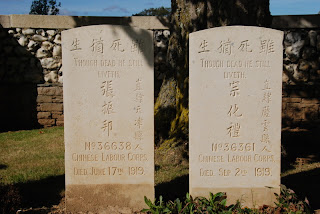Despite the fact that the store doesn't
open until 08:00, the muzak is switched on at 07:00 when the staff
start to arrive. I have thought that the staff may have demanded that
the music is played all of the time that they are at work but, given
that they can't be that mad, I have decided that they switch it on
when they arrive to make sure that they don't forget later. Anyway we
wake up to the gentle, if inane, background muzak and switch on BBC
Radio 4 (Long Wave) to drown it out.
After breakfasting on lovely, buttery
croissant, we topped up the water tank and set off. As always, we try
to avoid motorways and major roads, preferring the excellent and
deserted minor roads. This journey did not disappoint. There had been
rain overnight but we were blessed with sunshine and excellent
visibility as we travelled through lovely countryside and pretty
villages. This area saw a great deal of fighting and death during the
First World War and the fields and villages are littered with war
cemeteries. We found a British War Cemetery at Ecoivres and stopped
to take a look. There were many graves of Portland stone marking the
graves of Commonwealth soldiers (British, Canadian, Australian and
South African) but the cemetery was originally used by the French and
many stone crosses marked their graves. There were also four graves
of German soldiers but we were unable to find them.
A little further on we saw a sign to a
Chinese and Indian War Cemetery at Ayette and were intrigued as we
hadn't even seen Chinese or Indian WWI graves. The Indians were
labourers, drivers or in the Central Indian Horse but the Chinese
were all in the Chinese Labour Corps. The surprising thing about the
Chinese graves were that most of them died after the war had ended,
mostly in 1919 and one as late as September. Why all so late? I have
made a mental note to investigate further when I have access to the
Internet. The inscriptions on the graves were also most unusual - “A
good reputation endures for ever”, “Faithful unto death”, “A
noble duty bravely done”.
We got distracted on the way and
changed our plans on a number of occasions. Looking at the map we
spotted the Clairiere de l'Armistice just off our intended route and
decided to pay it a visit. It was here that the armistice was signed
at the 11th hour on the 11th day of November
1918 in a railway carriage to end World War I and where Hitler
insisted that France signed their surrender, in the same railway
carriage, in 1940. We visited the museum here and saw an identical
railway carriage fitted with the original furniture from 1918 – the
original carriage displayed in Berlin was destroyed on Hitler's
orders at the end of WWII because he wanted to prevent it from being
used by the Allies for Germany's surrender. The museum has many
souvenirs of WWI and an incredible collection of stereoscopic images
of the war. Well worth the €5 entry fee.
It was only a short drive to Attichy to
the aire, a car park outside the swimming pool, next to a very pretty
lake. A lovely position for the night.
Photos: Two Chinese graves in the
Ayette Cemetery – note the dates; View over the lake at the Attichy
aire.


No comments:
Post a Comment